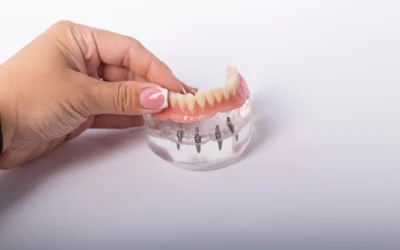Temporary crowns serve the dual purpose of providing functional and aesthetic benefits while patients are waiting for a permanent dental crown to be fitted. They allow patients to speak and chew as normal after a dental procedure, and they also help to protect the sensitive area from harm while a permanent crown is being fabricated.
This article will cover key questions that patients have about their temporary dental crowns, including how to care for your crown and what to do if you feel any discomfort or pain.

What are temporary dental crowns and why are they important?
Temporary crowns are temporary restorations used in dentistry to protect a prepared tooth until a permanent crown can be placed. They are designed to mimic a patient’s natural tooth, having both functional and aesthetic properties.
Temporary crowns protect the underlying tooth structure from damage, sensitivity and bacterial infection while the permanent crown is being fabricated. The result is that patients can chew and speak just as they normally would while waiting for their permanent restoration.
While they operate as both a functional and aesthetic placeholder, temporary dental crowns also enable dentists to evaluate the fit, comfort, and look of the crown compared to the natural tooth. Overall, temporary crowns play a crucial role in the dental restoration process and enable permanent dental crowns to be fitted seamlessly.
When would someone need a temporary crown?
Temporary crowns are significant in maintaining oral health, acting as a barrier that protects the natural tooth from damage while waiting for a permanent crown to be placed. There are several scenarios in which a person might need a temporary crown.
During the crown fabrication process
First, and possibly the most obvious scenario, is that people need temporary crowns while they’re waiting for permanent dental crowns. Permanent crowns are tailor-made for each patient depending on the formation of their teeth and the shape of their oral cavity, and the fabrication of permanent crowns can take a couple of weeks after preparations have been made. As a result, a temporary crown will be used to bridge the time gap and test the measurements.
After a root canal treatment
Another key scenario in which a person might need a temporary crown is after a root canal procedure. Root canals target the pulp of the tooth, where the nerves, blood vessels, and connective tissue are contained. Once root canals are completed successfully, a temporary dental crown is used to protect the damaged tooth and restore its functionality until permanent crowns can be placed.
Other key scenarios
Temporary crowns can also be used in cases of decay or dental trauma, where a tooth has been badly damaged or weakened. Additionally, temporary dental crowns may be used to protect a tooth that is undergoing various treatments, such as a dental implant treatment or as part of a dental bridge preparation.

What is the process of getting a temporary crown?
The procedure for getting a temporary crown is performed in two separate appointments. The first appointment is to prepare the oral cavity for the placement of the permanent crown, and to place the temporary crown to protect the mouth and teeth. The second appointment involves removing the temporary crown and fitting the permanent version into the mouth perfectly.
First Appointment: Preparation and Temporary Crown Placement
The first step at the beginning of the first appointment is that the dentist will need to conduct a thorough examination of the affected tooth (or teeth) and determine the need for a crown. To analyze what the natural tooth requires, x-rays may be taken to assess the tooth’s structure and its surrounding tissues. Next, the tooth will be prepared to accommodate the crown.
During preparation, the patient will receive local anesthesia and the dentist will remove any decayed or damaged areas from the tooth. This involves reducing the size of the tooth to make room for the crown. Once the tooth is prepared, the dentist takes an impression of the tooth that will carefully match the patient’s other teeth. This impression, or mold, will be used to fabricate the permanent crown.
Using the impression, a temporary crown is custom-made in the dental office or in a dental laboratory using provisional crown materials. Temporary crowns are made from acrylic or composite resin, and there can be some variety depending on the manufacturer. Once the crown is made, it is then placed over the prepared tooth and checked for fit, bite alignment, and aesthetics. The dentist may make adjustments at this point to ensure a comfortable and secure fit.
Finally, the dentist will fix the crown into place using temporary cement, which allows temporary dental crowns to stay in place until the permanent crowns are ready. Since there is an interim period of a few weeks, the dental cement keeps the temporary restoration secure while still enabling the dentist to remove the crown easily during the next appointment.
Second Appointment: Permanent Crown Placement
In the second appointment, the temporary crown is carefully removed using specialized tools and a traditional permanent crown will be fitted. At this point, a final crown evaluation will be made to ensure that the fit, color, and aesthetics of the new crown are perfectly matched to the patient’s expectations.
Once approved, the permanent crown is fitted onto the prepared tooth using dental adhesive or cement. Then, the dentist checks the bite alignment and makes any necessary adjustments to ensure a comfortable and functional bite with the new crown.

Caring For Your Temporary Crown
Caring for dental crowns is essential to ensure their durability, stability, and the overall success of a restoration. Beyond best oral hygiene practices and scheduling a check-up if you feel any discomfort from your temporary crown, there are several things to remember when you get back home.
Avoid hard and sticky foods
Temporaries can be sensitive to pressure and may become dislodged or damaged by certain kinds of foods. Make sure to avoid chewing on hard candies, ice, nuts, or sticky foods like caramel and chewing gum until a few weeks after the permanent restoration.
Be gentle when chewing
When eating, try to chew on the opposite side of your mouth from the temporary crown to reduce the risk of damage. Use caution and chew slowly to avoid putting excessive force on the crown.
Take extra care during your oral hygiene routine
When brushing your teeth, make sure to do it gently — especially over the area where the temporary crown is placed. You should also floss gently to clean the affected area, but you need to avoid pulling up on the floss as this can dislodge the crown. Instead, slide the floss out from between your teeth slowly and with care.
Additionally, alcohol-based mouthwashes can weaken the temporary cement used to hold the crown in place. Make sure to use a non-alcoholic mouthwash or follow your dentist’s recommendations for oral rinses.
Wear a mouthguard during contact sports
If you engage in activities that could impact your mouth, such as contact sports, consider wearing a mouthguard to protect your temporary crown and the weakened tooth underneath from any potential damage.
What are some common concerns regarding the placement of a temporary crown?
Fitting dental crowns may cause gum sensitivity around the affected area, often resulting from inflammation, irritation from the crown, or exposed dentin. If you experience pain, tenderness, swelling, or bleeding in the gum line near the temporary crown, you must contact your dentist immediately.
Another key concern is if the temporary crown falls off or is partially dislodged. This can occur for a variety of reasons, including chewing on hard or sticky foods, improper fit, inadequate dental cement, or accidental trauma.
To help patients avoid gum sensitivity or crown displacement, it’s important to adhere to your dentist’s recommendations for post-treatment care. Maintaining careful oral hygiene practices and avoiding certain foods will help to prevent any negative side effects once the crown has been placed.

A Final Word From My Emergency Dental
A temporary crown plays an important role in dental restoration. They provide functional benefits, such as helping a patient to chew and speak as normal, as well as aesthetic benefits, providing patients with a natural-looking smile while they wait for their permanent crown to be fitted.
It’s important to note that each dental crown is different, being tailor-made by specialists in a dental laboratory according to the patient’s specifications. With that in mind, patients should always return to the dentist who fitted their crown if they experience complications after treatment.
For more advice on temporary dental crown placement and care, visit the My Emergency Dental offices in Marietta or Stockbridge for a personalized consultation and to receive provisional restorations.



